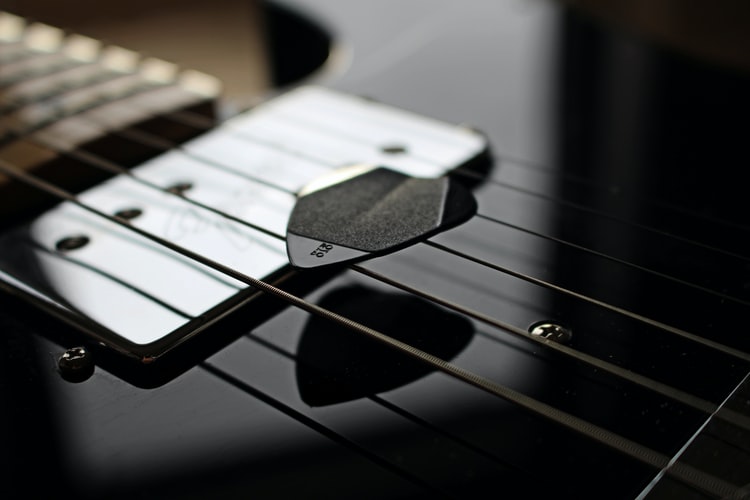Did you know the guitar pick is a resonator? This is important because they can have a vital role in how your guitar sustains and shapes your tone!
Guitar Pick Types? The most common types of picks include standard pick, thumb pick, and fingerpick attachments. These all vary by material but the most common are plastic, Nylon, and Celluloid. However, you can get them in carbon fiber, metal, wood snd ceramics. Whereby, they vary in Thickness, Texture, and design!
In this article, we will look at the pick types in more detail… Let us get started!
1. Material Types For Guitar Picks
The material your guitar pick is made from will directly shape, and there are plenty to choose from. For this reason, choosing your best guitar picks is not always an easy task.
The different materials you can find include:
- Plastic
- Nylon
- Celluloid
- Carbon fiber
- Metal (copper, steel)
- Wood
- Ceramics
- Glass
- Stone
- Others (Horn, bone, leather, shell)
We will go through each of these below…
PLASTICS (NYLON, CELLULOID, CARBON FIBER)
Plastic guitar picks are the most popular guitar picks on the market, and can be obtained from almost any guitar or musical instruments store.
I will always use the iconic purple 1.5mm plastic picks as they are inexpensive, perfect for playing fast, and sound really good!
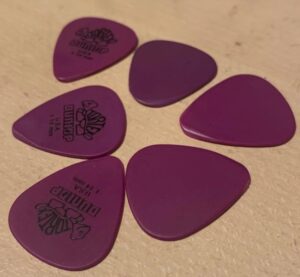
For this reason, plastic guitar picks will always be the most popular. If you have never used plastic before and looking for an alternative then I definitely recommend it!
So I will always make sure I’m stocked up on these!
NYLON
Throughout the development of guitar picks, nylon, as a material, has been praised for its unmatched flexibility.
Thanks to this property, nylon guitar picks are generally known for the warm, sweet tone they produce. Its flexibility also allows for tighter, more aggressive sound when struck hard. Nylon picks are highly recommended for guitarists who dabble in multiple genres, from the mellowness of jazz to the more progressive rock music.
Also, because of said flexibility, nylon picks are manufactured with a relatively thick gauge to counter floppiness, even though they will always feel thinner than their actual thickness.
Apart from its low rigidness, nylon guitar picks are overall more slippery than other materials. And for this reason, the surface is usually designed with a raised pattern for enhanced grip. Flexibility also warrants wearing and breaking after long use.
But with that said, it’s not like anyone can hold on to a guitar pick until it breaks. Plus, these picks are cheap, on the off chance that the one you are using gets stuck in the sofa, in a sound hole, or simply disintegrate into thin air, you can always buy another or simply stock up on dozens of these.
CELLULOID
Celluloid is one of the first synthetic materials used to produce guitar picks. Celluloid became famous as a more humanitarian alternative to the illegal tortoiseshell. Similar to the tortoiseshell, celluloid is one of the harder materials for plectrums in general. In fact, celluloid is much more rigid than other plastics used. When it comes to sound, celluloid picks are definitely on the brighter side of the spectrum. Its brightness can be further heightened by using harder and more aggressive picking techniques.
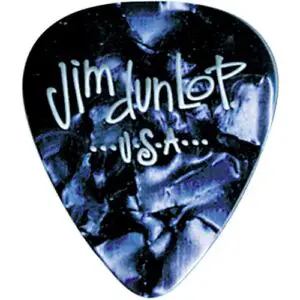
Its rigidness, however, is not consistent with the thickness of picks. For lighter gauges, the pick can become a bit too flexible and often will create the “plastic sound” from the picks flexing with each stroke. At higher thickness, the picks can be very stiff but effectively removes the plastic sound of thinner picks. However, thicker gauge can be difficult for unfamiliar or beginner guitarists. Durability wise, celluloid picks are not great. For thinner and more flexible picks, they are prone to wearing, becoming more frayed as time goes. Worn-down picks effectively reduce the brightness and vividness of the tone. Thicker and harder picks are not susceptible to wearing, but to breaking. They can hold the tone for quite a while but after long usage, they will likely snap. Either case, you will need to stock up on these picks, they are cheap anyways.
CARBON FIBRE
Carbon fibre is quite an exotic material, especially for guitar picks. Appearance wise, carbon fibre is most certainly one of the coolest materials. The distinct pattern of carbon fibre is easily distinguished from more common plastics. A deeper look inside this material reveals even more interesting properties. Used for the chassis of supercars, carbon fibre is incredibly stiff and light, it’s said that it is five times harder than steel, yet lighter than aluminium. Carbon fibre picks are, unsurprisingly, more expensive than other guitar picks made from plastics. But the price tag is not crazily high, and considering their offerings, they are definitely worth the investment. You may not want to buy them in bulk though.
Because of its stiffness, holding a carbon fibre pick is quite an experience in itself. Even for a lighter gauge, the stiffness is unbelievable, even on par with extra heavy gauge. But on the other hand, the pick feels so light, more so than even the lightest plastic. Such stiffness is able to produce a distinct bright and tight tone. Yet, thanks to the property of carbon fibre, the picks are usually produced at lighter gauge, thus, making it much less intimidating for beginner guitarists who would like a more powerful tone but is yet to familiarize with thicker gauge.
Carbon fibre picks offer outstanding grip, too. The multifilament texture provides a rougher surface compared to other plastic picks, making slipperiness a non-issue. In play, these picks will take time to get used to. The picks can feel rough on the strings due to the material patterns. Once you get used to it, it becomes much more fun, the tones are bright and powerful, the grip is great and the weight is seemingly nothing.
METAL (COPPER, STEEL)
Metal and alloy are very versatile materials. Metals are naturally harder and more durable than most plastic materials, except for carbon fibre and other advanced synthetics. For this reason, they are capable of bringing out intensive brightness and clarity. Surface texture is also one of its strong points. Smooth and sharp, metal picks allow players to glide effortlessly across the strings, aiding significantly in executing aggressive string attacks. Thanks to these properties, metal picks are often chosen by guitarists from rock and metal backgrounds. The most popular metal guitar picks are copper, steel and their alloys.
COPPER
Copper, as well as its alloys, is on the soft side amongst metals. In fact, with some effort, you can bend a copper or bronze guitar pick permanently altering its tone and playability. Metals are not as flexible and soft as plastics. Therefore, if you want to hold on to that pick, be sure to take good care of it.
Thanks to its relative softness, copper guitar picks can produce warmer and sweeter sound compared to other metals and at the same time, they are not as flimsy as plastic guitar picks so you can rest assured that plastic sound is nowhere to be found with these picks. Softer guitar picks also means less stress and damage to the guitar’s strings and body. Strong, thick materials designed with an acute point is an invitation for deep scratches and string breakage.
Bronze, a harder alloy of copper, is guaranteed to deliver a more aggressive sound. They are still able to retain a fraction of the coppers warmth, added a hint of power, perfectly fit for faster and more ferocious playstyle.
Despite its metallic nature, copper guitar picks are the best as the middle point between softer plastics and stiffer metal. If you want a step-up from the usual plastic but not really into powerful music genres, give these picks a try. Apart from sounding much brighter and stronger, they have that metal flair you know plastic guitar picks can give you.
STEEL
Steel is much harder than copper. Also, its durability greatly surpasses that of copper and any copper-based alloys, so no worries about your picks getting bent or nicked. Steel guitar picks, in addition, will provide you the iconic tone of metal guitar picks: perfect brightness, quick attacks and frictionless string contact.
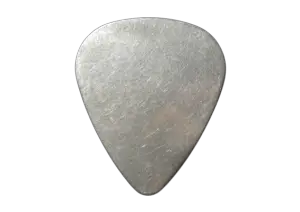
But this package of aural sweetness is followed by other traits less desirable. Firstly, a metal guitar pick is more than likely to damage the body of your guitar, the finish, the strings, even the fretboard. Steel is a strong, resilient material and will not take kindly to rough contacts. Thus, take caution when you pick up a steel pick or you will find yourself restringing quite often. Secondly, steel does not provide sufficient grip. Their smooth surface performs best in picking and strumming but at the same time does not prevent slipping from your fingers, especially for long playing. To combat these issues, plectrum manufacturers try to add carving and texture to the picks, but the hardness of steel is not very forgiving to the human skins, and will become quite uncomfortable.
But once you pass all of these hindrances, the steel picks will give you a sweet guitar experience. Their playability and tone are nothing but top-notched, the flawless complement to heavy metal and other extreme genres.
WOOD
These picks are for those who wood like a more exotic selection for their picks. Wood is not the material of choice for many manufacturers, and the reasons quite understandable. Wood is not as economical as other alternative materials. Some wood species are vastly more expensive than obtainable and common metals or plastics. And manufacturing cost is another birch, too, as wooden products often cannot be done by automation and, thus, requires manpower instead. And lastly, wood, as a whole, is not resistant to constant and strong contacts, and as a result, wooden picks wear out quickly and easily. With that said, wood species branch out quite a lot, and hardwood can hold an edge to a degree.
In play, these wooden bois can overshadow other picks in some criteria. Wooden picks have its own natural timbre. Their tone is warm, rich and vivid but not focused strongly on the high notes, but instead, on the middle. As such, their sound is balanced and clear, great for control playing. In addition, wood is a hard and brittle material, they do not give much flex compared to plastics but at the same time, they are not woodpeckers to the strings either. Consequentially, they do not give out that annoying plastic sound and will be a little gentler to the guitar. And thanks to the wood pattern combined with finish, a wooden pick will provide a decent grip and easy string contact. However, handling a wooden pick is definitely not easy as it is much stiffer and thicker than other picks, but once you get used to it, you wood surely love it.
CERAMICS, GLASS, STONE
CERAMICS
Ceramic is hailed as one of the hardest materials and still is accessible. And as ceramic is widely used for production of fine arts around the world, why not make it something more productive in actively creating art itself. Nowadays, ceramic guitar picks are easily obtained from vendors and guitar shops. There are even manufacturers fully dedicated to producing these picks.
Ceramic guitar picks are very different from picks made from other materials. Heavier than most others, ceramic picks can be manufactured at a lighter gauge. And even at this gauge, they still feel weighty compared with other picks. Thicker gauges, even at 3 to 4mm can also be found. And expectedly, these picks can become a challenge to get used to and wield effectively. Ceramic is also a very smooth material, but also not overly difficult to work with. To compensate for being slippery, the picks are given soft patterns or texture in order to give a better, firmer and more comfortable grip.
In play, ceramic picks are intrinsically different than other picks as their focus is mainly on the low end of the sound spectrum, giving the guitar a more powerful tone. Ceramic picks can deliver the resonance few guitar picks can, the sound rings louder and last much longer. The strengthened lows do not drown out other notes but works extremely well in complementing the whole piece. They are also completely devoid of that plastic sound, giving the players the perfectly clean performance.
GLASS
Glass itself is very similar to ceramics as a material. Glass is also much more popular and friendlier to work with than ceramic and thus, friendlier to your wallet as well.
As they are very similar to ceramic, glass guitar picks will give you that heavy feel as well. However, glass is not as hard as ceramic and for it to stand the test of time, glass picks are usually manufactured at relatively thick gauges, much thicker than those available for ceramic. The good thing about glass is that they are easier to temper with than ceramic, fitting the picks with designs, patterns are, for this reason, much easier. In terms of aesthetics, glass picks can come in many colors and designs. Having a cool-looking glass pick in your collection is certainly a must.
String interactions are definitely a strong point. Glass picks feel smooth in contact with the strings. And even though the weight may prove difficult for some guitarists to handle, it does add a certain degree of control to your picking. Sound wise, glass picks are all about power. They have the similar low ends of ceramic picks but also focus some of its energy on the highs and the mids. The final product is the perfect blend of sound sweetness and thick volume.
STONE
In case you find yourself bored of the everyday plastic or metal picks, trying out a stone guitar pick is definitely a breath of fresh air. Stones for guitar picks can come in a wide variety, offering many aesthetic options but in terms of sound, types of stone do not vary significantly.
On hand, stone picks give a similar feel to that of ceramic or glass: smooth to the skin and noticeably dense. Similar to ceramic and glass, stone picks are grinded until smooth so you can always expect a very comfortable guitar pick. Stone offers a good grip, too. Many types of stone can have different natural patterns unique to that piece only, and thanks to the finish, the patterns should never feel sharp on your skin. Also, thanks to the natural patterns, each stone pick may be the only one of its kind, and no other picks can look the part. The pick edges are always grinded smooth thus it should not damage your strings, while give it certain characteristics. As stone is hard and very brittle, you should expect the picks will come in relatively thick gauge, although not so thick that it will become a hindrance, usually found from 1 to 2mm.
Stone picks have a that unique tone to it, too. They can create very powerful sounds, incredible resonance and overall balance intonation. With stone guitar picks, you can expect that thick, creamy tone accompanied by very well-defined aural characteristics.
And similar to metal, stone is a very strong and hard material. A stone guitar pick can definitely last you a lifetime, and even beyond (provided that it does not travel to pick dimension during its time of service). But also, it pays to take caution that stone guitar picks can damage your guitars as well.
OTHERS (HORN, BONE, LEATHER, SHELL)
A few craftsmen do manufacture guitar picks from more prestigious materials. The chosen materials are more than often those that are not widely available on the market such as horn, bone, or leather. Of course, the idea of making products from animals has been shunned by people nowadays. In fact, a few materials from animals have been banned, and for guitar picks, tortoiseshell is a prime example as this practice has been endangering the lives of sea turtles.
BONE
Bone has been used to manufacture art pieces since the beginning of time. And of course, a usable fine artefact would certainly please a lot of us. In fact, bone has been used to build guitars even to this day; guitar nuts and saddles are still fitted as statements of exclusive quality. As a material, bone offers unmatched density, which guarantees uninterrupted, pure sound conduction and clarity.

Bone guitar picks are promised to deliver a tone balanced across the sound spectrum. They have that sweet and gentle warmth suitable for jazz players. The surface texture is usually ground until smooth to have as little friction with the strings as possible. Bone picks are not too hard, either, and will not damage your guitars or wear out the strings significantly. Their high density also means high durability, as such, the picks will surely stand the test of time. They do have one major weak point though: their price. But then again, we are living in a world of capitalism.
HORN
Horn is an alternative material for tortoiseshell. They are similar in the way that tortoiseshell and horn are both organic material, both have the distinct “natural” feel and they are quite similar in tone, too. But, horn is much friendlier than its aquatic cousin: it is easily obtainable. For guitar pick manufacturing, most picks you find on the market is buffalo horn.
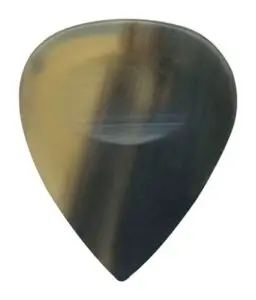
Hands on, horn guitar picks feel smooth, hard and light, quite similar to celluloid, which is the intended synthetic alternative for tortoiseshell. They are quite similar to glass, too, albeit not as fragile and heavy. Horn offers sufficient grip thanks to the textured surface, which consists of many keratin layers and patterns. Most horn guitar picks are given beveled edges for an almost frictionless contact with the strings.
In terms of sound and intonation, you can expect the usual serving as any organic guitar picks. Horn picks give you clear and tight sounds and superb resonation. The hardness also offers the power behind each stroke while leaving behind no noises, the clarity is unmatched by any plastic guitar picks. Then again, the power is not the same as other metal picks but instead has its own warm and natural resonance.
Horn picks are recommended for blues and country guitarists. They are fast, light, and have a sweet balance of power and warmth. And again, like other organic materials, horn is pricy and rare. On the one hand, you have a cool story for your friends, on the other, your wallet may weep for any purchase. On another note, horn picks are not known for their durability, they do not hold well against constant contacts and will wear down quickly. After all, they are fingernails, in a way.
LEATHER
Amongst the organic materials in this list, leather is definitely amongst the most versatile and most obtainable. For plectrum manufacturing, the leather is usually tanned, resulting in a certain degree of both firmness and flexibility. However, in order to create the rigidness suitable for playing guitar, leather picks usually come in relatively thick gauge, available from 2mm to even 4mm. Unfortunately, this thickness may not entirely complement the playstyle of some guitarists, and definitely beginner guitarists. But once you get used to this gargantuan size, you are blessed with its sweet and thick tone, one that only leather can give.
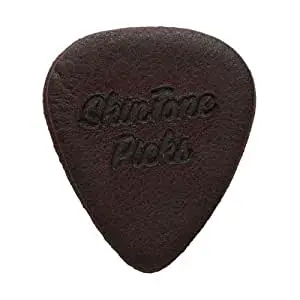
Holding a leather pick is quite an experience itself. Despite its unusual size, a leather pick can feel almost weightless in hand. Depend on the type of leather used, a leather pick can have a textured surface or a smooth, virtually unwrinkled one. But regardless of the types of leather, leather never to fails to offer a great grip. The leather surface always feels gentle on your fingers, giving you an unmatched comfortability. The grip is the one advantage of leather picks from other materials. Even after long playing sessions and sweat starting to kick in, the pick should never let go of your hand. For other materials to combat this issue, manufacturers usually have raised patterns fitted in or have the surface curved in, which might result in irritation on your fingers after one hour or two. This, however, is a nonissue in leather guitar picks.
In the test with the strings, the leather pick is definitely a strong contender. The bevels can be left as are, giving a slight texture when struck against the strings. This option will give your tone more timbre, adding in a few sound characteristics. On the other hand, the bevels can be ground and given a finish and become harder, smoother, and thus better playability. In both options, leather picks in general are vivid in tone and at the same time, warmer than most plastic picks.
Leather picks are recommended for classical guitars or nylon strings for longer life expectancy, which is understandable due to its fragility.
ABALONE SHELL
As far as aesthetics goes, you can hardly find a guitar pick as stunning as one made from abalone shell. Abalone, as a material, has a shiny appearance, decorated with colorful layers and patterns and after process it is smooth and reflective. Abalone is known for its rigidness and also brittleness and, thus, it is hard to work with and in turn, they are also very expensive.
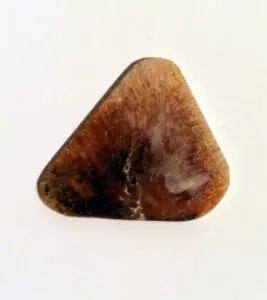
As guitar picks, abalone has that luxurious feel on hand. Its smoothness is comparable to that of pearl, crystal or marble. The surface is well ground, and for this reason, abalone picks are quite slippery on the fingers. They are weighty on hand, too, comparable to bone or metal. Fortunately, their hardness allows abalone picks to be manufactured at relatively low to standard gauges, usually at around 1mm. This thickness is not intimidating to most guitarists and abalone guitar picks can suit a lot of players. Its smooth surface and bevel also allow for high playability. Unfortunately, its poor grip is quite untreatable since abalone is very hard to work with and engineering soft, comfortable patterns are not really possible and no one would want to fit a piece of rubber on such a precious piece of art just for better grip.
Abalone picks have a tone as high-class as their looks: heavily focused on the highs. This is the standard amongst harder and inflexible guitar picks. It is bright and clear but the high notes do not drown out the lows. Abalone picks are recommended for lead guitarists who mainly work with high notes and need improved saturation. Nevertheless, abalone can feel a little too bright for some. Thus it goes well with dark guitars for better balance.
These days, abalone is becoming harder to come across and at some parts of the world, exploitation of this species is strictly restricted and inhibited. For these reasons, abalone guitar picks are very expensive and usually acquired as a collection piece. On a side note, many synthetic materials can achieve the sound structure similar to that of abalone. Although you can always pick up an abalone pick to have a story with your friends.
2. Guitar Pick THICKNESS
In this section we look at the thickness of a guitar pick and the properties of each;
- Thin
- Medium
- Thick
- Extra thick
Different from the standards for human, whereby thickness only accounts for superficial values and the memes; in the realm of guitar picks, the size plays a pivotal role, perhaps even equivalent to that of the material itself. Understandably, the characteristics of guitar picks of the same materials may vary significantly according to how thick they are. This, in turn, will alter weight, hand feel, hardness and playability. And thus, similar to the material, choosing the right thickness for your guitar picks may be long and arduous and will take you a few misses to have a right.
THIN (0.4-0.6MM)
Thin guitar picks are probably the most popular of all the gauges. You would occasionally come across thin plastic guitar picks in guitar shops or music events.
Thin picks in general are light regardless of the materials and also because of this, their tone is usually not as chunky or powerful as thick picks. Amongst seasoned guitarists, thin gauges are usually frowned upon as they are notorious for the unaesthetic flappy or washboard sound, this is especially true for plastic guitar picks. For this reason, more than often, thin picks are not recommendable for lead guitarists. For light picking and practice purpose, thin picks can give a pleasantly balance in tone, not oversaturated in highs or lows. With that said, thin picks made from rigid materials, such as metal or hard plastics, can produce very bright and aggressive tones, fitting for more power-focused play style.
Extreme thinness, in addition, is not highly recommended. Although they feel almost weightless in hand, they offer weak or very little grip, further compromising controllability due to their high flexibility. In other words, very mediocre playability.
MEDIUM (0.6-0.8MM)
Guitar picks of this gauge are perhaps the most recommended for guitarists of all backgrounds as thin guitar picks are more than often too flexible for optimal playability and well-rounded tone. Medium thickness can help remedy these shortcomings. If thin guitar picks have a light and warm tone, medium picks bring about more power, volume and greater balance. Medium picks may as well be a more fitting choice for rhythm and riffs than thin picks as they are more well-rounded and can give more oomph for the low notes. Higher rigidity and density may not be ideal for strumming on an acoustic as the sound will be a tad darker, heavier and not as resonant. Then again, no official rules ever dictate how one plays their guitars. If it sounds good to you, rock on.
In terms of playability, medium picks are more suitable for beginner guitarists as they are stiffer and heavier, which allows for higher control and tighter grip. As for thin picks, you have to pay extra attention so not as to produce the flexing sound, with thicker picks, it is mostly eliminated. Plus, a moderate thickness should provide more grip, less worries the pick may slip while playing.
THICK (0.8-1.2MM)
Thick guitar picks are most suited for aggressive and heavy playing. Specifically made for lead, solos and shredding, thick picks can give you the extra gunpowder you need for heavy metal or rock. Apart from the added volume and power, thick guitar picks have a fatter tone as well. The bass is highly elevated while the treble retains the clarity with highly emphasized grit.
While a bit thicker than medium picks, the difference is not too accentuated and with time, anyone can play comfortably and effortlessly. Grip and playability should not be too distant, either. Thicker picks, which certainly assure more weight, can have more control over medium picks, further complementing fast picking and accurate play style.
EXTRA THICK (OVER 1.2MM)
In case thick picks are not enough for you, either not enough power or you need more weight and control, picking up an extra heavy one is certainly an option. However, extra thick gauge can be harder to come across and will definitely cost you much more as well.
These guitar picks are usually limited in production, made by skilled artisans and from high quality materials, or produced by special order. They can be as thick as possible. Purple Plectrum, for example, produce prestigious handcrafted picks from 5mm up to 25mm.
In terms of sound, extra thick picks can produce fuller and richer tone due to their extreme density and weight. As for control and playability, some players are more comfortable with even 10mm picks. At the end of the day, the perfect guitar picks are up to subjective preference.
3. Guitar picks SHAPES
In its primal age, guitar picks are given various shapes with simplicity at its core. As the golden age of guitar came, guitar picks were further revolutionized, starting from the minimalistic triangle shape, the picks were then given curved edge, sharp angles. Nowadays, while the triangular design of the guitar picks is still most popular in the realm of guitars, bizarre pick shapes are emerging, thriving, in order to accommodate ergonomics, tone and playability. In this section we look at the range of shapes available on the market, including;
- Equilateral
- Standard
- Sharks fin
EQUILATERAL
One of the primitive and essential designs for guitar picks and yet still plenty versatile and friendly for beginners. Equilateral picks are triangular in shape, featuring three acute rounded angles. Thanks to their relatively large size, these picks are easy to hold and do not take beginners much time to get used to. The three angles also provide three possible striking tips for guitarists, which can be used interchangeably in case one tip is worn down.
STANDARD
Standard shapes are perhaps the most common for nowadays guitar picks. They are essentially the triangular guitar picks with curved sides and a more pronounced striking tip, similar to a teardrop or shark tooth. These days, manufacturers tend to modify the tips and the tapers in order to add more characters to the sounds and enhance playability. For instance, the tip can be sharpened to deliver a smoother contact with the strings and guarantee a warmer tone.
SHARK’S FIN
One of the more liberal designs for guitar picks, shark fin picks take the shape of a shark fin, instead of its tooth. Shark fin picks offer a few edges over the traditional triangular design. They are a bit larger in size, providing more room for a tight grip. These picks are originally designed for overall versatility. In place of the standard rounded striking tips, there are a more pronounced tip and a rough edge, eliminating the needs for different picks as the pointy tip can be used to create more aggressive tones while the rough edge is recommended for scrape picking. Besides, this pick is certainly more striking than other standard options.
4. Guitar pick TEXTURES
Different textures can bring about different attributes and experience, such as a better grip or less string friction, for instance. While surface texture is sometimes unique to the material itself, guitarists, on occasions, try to temper with the surface texture themselves to create a more personalized guitar pick. This can be done by scratching the surface or putting on paper tape for a better grip. In this section we look at the different textures available including;
- Polished
- Sanded and pattern
- Grip holes
POLISHED
Polished tip is smooth on the string. The polish significantly reduces string friction, adding to the durability of the picks. A smooth tip will also allow for a warm and tight tone accompanied by superb clarity and control. Polished picks are the choice for many guitarists for this reason. However, a smooth surface allows for very little friction and, as a result, very weak grip.
SANDED & PATTERN
These picks are the remedy for pick slipping in play. The rough and aggressive surface guarantees a tighter grip. These picks are usually less likely to slip and move in your hand however, they are not very gentle on your skin either and holding them too tightly or too long can be quite uncomfortable. The rough edge can have a few noises in the sound and more aggressive string contact. While to some players, this is not quite the optimal experience and would opt for a cleaner sounding pick, to a few others, this noise adds subtle characters to their tone and thus they prefer the rough edge. However, guitar picks can always come with polished edges.
GRIP HOLES
As sanded and pattern surface may be too aggressive on the skin and are not comfortable for long playing sessions, grip holes surface seems to be a friendlier option. These picks are usually polished but with a few holes punched on the hold area of the picks to have more a more gripping surface. Grip holes are not as pronounced compared to sanded and pattern and thus more suitable for long sessions. Furthermore, they can still have the durability and clean sound of polished guitar picks, therefore making them a decent compromise for good grip and clean tone.
5. FINGER PICKS & THUMB PICKS
There is usually a saying: why buy a guitar pick while you already have five? This saying rings true most of the time but not so much when the nails break. Furthermore, finger nails are quite high-maintenance gears themselves: they tend to break or chip when wet; the edges require regular filing; newly cut nails are produce very aggressive and gritting tone, which acoustic guitars are not made for. For this reason, finger picks and thumb picks do seem like a suitable alternative to finger nails.
THUMB PICKS
As the name implies, a thumb pick is designed for the thumb. The thumb nail, in comparison with other fingers, does not make much contact with the strings and usually the meaty part of the fingers. As a result, the thumb cannot produce perfectly clear and tight bass notes (as the thumb is used to play bass strings), it is usually very warm and full but for faster and more aggressive genres, the thumb severely lacks in power. For this occasion, fingerstyle guitarists turn to thumb picks for more a gritting tone and faster execution.
Thumb picks are very essential in design, featuring a finger hold and a tip, which can vary in length and thickness. Choosing the right thumb pick can be very difficult. The fit needs to be perfect, the pick must not move at all as you do not directly hold and adjust the grip. A loose thumb pick will quickly come off during play or will significantly affect your performance by dampening the sound and hinder finger movements.
For both beginners and seasoned players, thumb picks will take time to get familiar with since it completely alters the how the thumb interacts with the strings. However, once you get used to it, thumb picks can greatly expand your guitar arsenal. The thumb pick is much faster than the bare thumb and much more powerful sound wise. Fingerstyle guitarists dabbling in percussive techniques can directly benefit from this picks, especially in thumb slap.
FINGER PICKS
Used for fingers from the index finger to the ring finger, finger picks usually come in set of three. Finger picks can be used in case the nails are not long enough for an optimal clarity and resonance as they can eliminate the friction between the strings and the skin. Finger picks can greatly alter the tone of the acoustic guitar, too. Depending on the material and the design, finger picks can produce distinguished tones and sound structure.
Different from thumb picks, finger picks can greatly vary in design: while the finger hold share similar general design, the tips come in many shapes and sizes, some imitate the shape of finger nails while others used wires, such as the classical butterfly picks, or plates in the vintage style finger picks.
They are similar to thumb picks in the sense that finger picks will take time to get used to and the effort in choosing the right fit. Once mastered, the finger picks can play a vital role in your performance. They are faster and more resilient than human finger nails and virtually require no maintenance. However, it should be noted that finger picks can limit the techniques you can use, such as artificial and slapping harmonics and tapping, since they directly affect the string feel, which is essential in fingerstyle guitar. With that said, a few percussive techniques can be enhanced with finger picks, string attack, for example.
CONCLUSION
we will look at;
- Material types for guitar picks
- Guitar picks thickness
- Guitar picks shapes
- Guitar picks textures
- Finger and thumb picks
Choosing the perfect guitar pick can be a chore, but it is worth it in the end as guitar picks are generally inexpensive yet directly affect your performance. But the perfect guitar pick is subjected to one’s own preference: how you hold the picks, how you strike with the picks, the techniques you will use and your playstyle. It will take time and a lot of testing but so is everything if it is perfection you are after.

